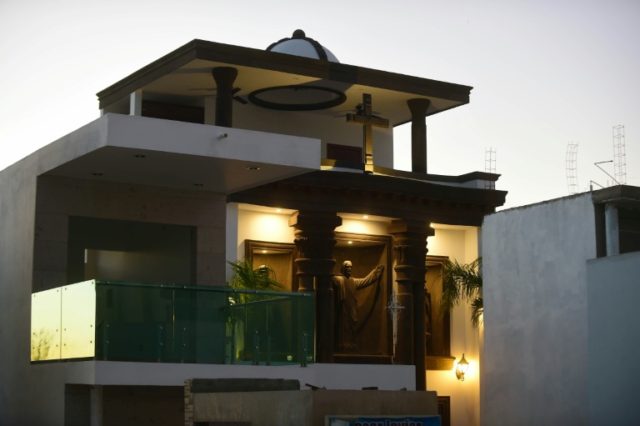Culiacan (Mexico) (AFP) – Some drug lords take their ostentatious lifestyle literally to the grave: a cemetery in Mexico is blooming with two-story tombs fitted with living rooms, air conditioning and bulletproof glass.
Mexico marked on Sunday 10 years since the government deployed troops in a drug war that has killed tens of thousands of people, with many victims buried unceremoniously in mass graves, dumped on roadsides or left hanging on bridges.
But the drug barons of Sinaloa state, the northwestern bastion of imprisoned kingpin Joaquin “El Chapo” Guzman, have given themselves more dignified final resting places at Jardines del Humaya cemetery in the regional capital, Culiacan.
One crypt looks like a chapel with white columns, angels on stained glass windows and a statue of Jesus Christ standing on the roof.
Others resemble small modern apartments with glass doors, stairs leading to a second floor and living rooms with couches for mourners. At least two of them were adorned with Christmas trees.
A crypt said to hold the remains of a Sinaloa drug cartel hitman has a bulletproof glass door, a cross that lights up in the dark on top of a dome, and surveillance cameras pointing toward the entrance. Inside, a glass case holds four small swords.
As night falls, lights are automatically activated outside several tombs. Many have alarm systems. One has fort-like towers, and another has a roof terrace with fans.
Most crypts have large pictures or paintings of the deceased on the wall — several look like young men in their 20s or 30s — but many of these tombs have no name to identify the person.
“It’s an expression of the power that they once had and a manifestation of their desire for eternity, which is natural in any human being,” said Juan Carlos Ayala, a philosophy professor at the Autonomous University of Sinaloa who specializes in “narco culture.”
“It’s also a demonstration for those who survive them that this man was important,” Ayala said.
New lavish mausoleums were under construction this week, awaiting for more drug cartel honchos to be gunned down. Ayala estimates that some of the crypts cost as much as $290,000 to build.
– ‘Narco culture’ –
The luxurious graves have become one of the symbols of the “narco culture” that has spread in the past decade, adding a religious facet to an underworld that has also inspired music, television shows, movies and fashion.
“Drug trafficking is permeating the community, through traditional culture, and now we almost have trouble seeing where one ends and the other begins,” Ayala said.
Some local governments have fined musicians who publicly perform polka-like ballads known as “narco corridos” that sing the praises of drug barons.
Some federal lawmakers wanted last month to prevent television networks from broadcasting “narco series” during primetime hours over concerns they could influence children.
The actors Sean Penn and Kate Del Castillo met with Guzman while he was on the run last year. After his capture in January, it was revealed that Del Castillo, who is Mexican-American, wanted to make a film about Guzman.
– ‘Supernatural protection’ –
Narco culture has also intertwined with religion.
Criminals, and millions of Mexicans, worship a skeletal death saint known as Santa Muerte, which is rejected by the Roman Catholic church as blasphemous but has even gained followers in the United States.
But many also pray to another folk saint called Jesus Malverde, who according to legend was a Robin Hood-type bandit who stole from the rich and gave to the poor until he was hanged in Culiacan in 1909.
“There’s a strong religious component to narco culture because if anyone needs supernatural protection it’s narcos who could be gunned down by rivals or law enforcement at any minute,” said Andrew Chesnut, professor of religious studies at Virginia Commonwealth University and author of the book “Devoted to Death: Santa Muerte, the Skeleton Saint.”
A green Jesus Malverde Chapel was built in his honor in Culiacan, where people can kneel in front of a bust of the dark-haired and mustachioed saint to pray for miracles.
People have left pesos on the walls but also dollar bills and currencies from Canada, Colombia and Cuba, along with pictures and thank you notes.
Fernando Lopez, a 35-year-old banker on vacation from central Mexico, visited the chapel “out of curiosity” because “you hear about this place all over Mexico.”
Nestor Paul Torres, a local 29-year-old flower seller, said he prayed to Malverde after he was wrongly jailed on bank robbery charges. He was acquitted two years later.
While in jail, he made an ornate wooden bust of Malverde, which now stands among other gifts left by worshippers whose prayers were answered.
“I got out thanks to him,” Torres, a Catholic who wears a cross, said after praying in front of the altar, which is surrounded by candles in a small room.
“A lot of people who come here are poor. That doesn’t mean we are narcos,” he said.
“Right now I’m asking for another miracle,” said Torres, who plans to hire a musician to sing to Malverde if he helps him buy a car. “I know that he will be able to do it.”

COMMENTS
Please let us know if you're having issues with commenting.